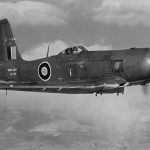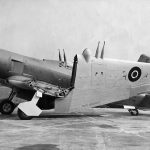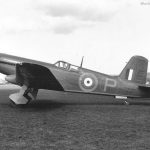Prototype Firebrand at Brough
Firebrand TF.5, HMS Illustrious 813 Squadron FAA
Firebrand TF.5 EK726 1948
Firebrand Mk I
Firebrand Mk 5 EK726
Firebrand Mk 4
Firebrand II aboard HMS Illustrious 1943
Firebrand III DK373
Firebrand III DK372
Torpedo-carrying Firebrand Mk 4 EK601
Crashed Prototype Firebrand DD810 11 October 1942
Firebrand DD804
Firebrand DD804
Firebrand TF.5 making an approach to HMS Eagle
Aircraft was originally designed as a single-seat fighter around the Napier Sabre III 24-cylinder liquid-cooled H-type engine. The first unarmed prototype flew on February 27, 1942, and the Mk. I prototype with full armament and military equipment five months later. At that time the Sabre engine was just going into production and because the Hawker Typhoon was more fully developed than the Firebrand, the Typhoon received priority for the new engine. It was therefore necessary to find an alternative power-plant for the plane and at the same time it was decided to widen its sphere of usefulness by converting it into what is commonly termed a “strike” aircraft, that is, one capable of striking with torpedoes, heavy bombs or rockets and, after release of its load, of operating as an offensive fighter.
Only nine production F Mk I aircraft were built.The Firebrand was unusual in that it had an airspeed indicator mounted outside the cockpit so that, on landing, the pilot did not have to look down into the cockpit to read the instrument, foreshadowing the development of modern head-up displays. At the time the service trials were underway, the Fleet Air Arm was operating the Supermarine Seafire as a shipborne fighter and a new role as a torpedo bomber was then planned for the Firebrand. The first attack version, the Fireband TF Mk.II (B-45), an adaptation of the Mk.I flew on 31 March 1943. It featured a slightly enlarged wing to allow the carrying of a torpedo placed between the main landing gear. Like the Mk I the TF Mk II had a limited production of 12 units, and was followed by the TF Mk. III with the Bristol Centaurus VII star engine. After the first flight on 21 December 1943, problems arose: the engine produced a greater rollover torque than the Sabre and the rudder controls were ineffective at take-off. The TF Mk. III was declared incompatible for carrier operations and work turned to an airframe better suited to the Centaurus. The aircraft had killed two test pilots when, after six months of modifications, Dennis Cambell achieved the first successful landing. The newly developed TF Mk. IV (B-46) carried the new Centaurus IX engine, with an increased tail area for better low-speed stability. The rudder was overhanging horn trimmed and the wings were fitted with airbrakes on the lower and upper surface. The first flight of the TF Mk. IV took place on 17 May 1945. It was the first version of the Firebrand to go into serial production with 102 units produced. The next, the TF.5, had slight aerodynamic improvements and was also mass-produced with 68 units entering service; 40 TF IVs were converted to TF.Vs.The last version produced was the TF Mk. 5A.













